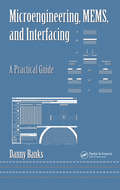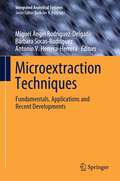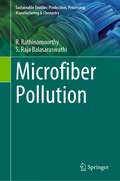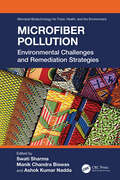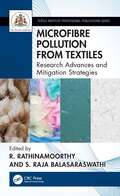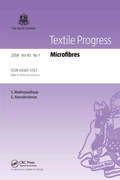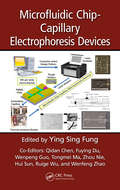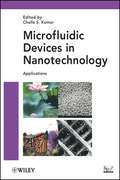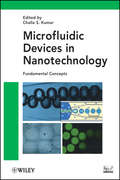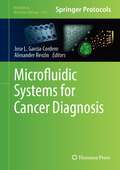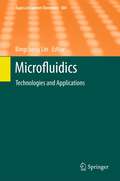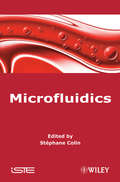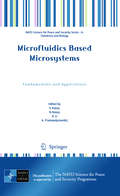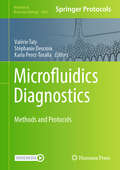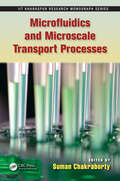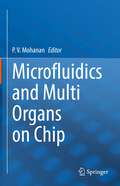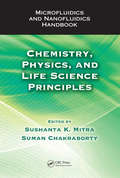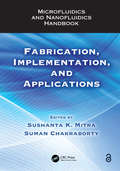- Table View
- List View
Microemulsions: Properties and Applications
by Monzer FanunThe effective use of microemulsions has increased dramatically during the past few decades as major industrial applications have expanded in a variety of fields. Microemulsions: Properties and Applications provides a complete and systematic assessment of all topics affecting microemulsion performance and discusses the fundamental characteristics, t
Microengineering, MEMS, and Interfacing: A Practical Guide
by Danny BanksMEMS devices are finding increasingly widespread use in a variety of settings, from chemical and biological analysis to sensors and actuators in automotive applications. Along with this massive growth, the field is still experiencing growing pains as fabrication processes are refined and new applications are attempted. Anyone serious about entering
Microextraction Techniques: Fundamentals, Applications and Recent Developments (Integrated Analytical Systems)
by Miguel Ángel Rodríguez-Delgado Bárbara Socas-Rodríguez Antonio V. Herrera-HerreraThis book presents detailed descriptions of the most relevant sorbent based and solvent-based microextraction techniques. The development of such miniaturised techniques is an important focus area in Green Analytical Chemistry as it allows for the reduction of toxic solvents and hazardous substances and decreases the complexity, cost, and time of analytical procedures. Numerous advances have been made in this field, and currently, there are a great number of microextraction techniques thanks to the development of novel materials such as nanomaterials and green solvents. This book provides an overview of the two main groups of microextractions, sorbent-based, and solvent-based. Each chapter focuses on the description of the technique fundamentals, the main applications, and the novel developments carried out in recent years written by a renowned expert or group of experts in the field. The main audience will be graduates, postgraduates, and researchers. It is also a useful resource for Master and Ph.D. students that are working in the development of sustainable extraction techniques
Microfiber Pollution (Sustainable Textiles: Production, Processing, Manufacturing & Chemistry)
by R. Rathinamoorthy S. Raja BalasaraswathiThis book provides insights into microfiber pollution in textile industries that would help researchers and professionals to work from the textile point of view to mitigate the problem, and create a green sustainable future. Microplastic pollution has received great importance due to its adverse environmental and health impact. Microplastic particles are found to contaminate the ecosystem. Research has reported microplastics on seashores, in deep seas, freshwater systems including rivers and lakes, and most importantly in the air. Various land-based and water-based organisms are also contaminated with microplastics. The most serious issue is when these particles are found in the food chain and air which can reach the human system. It has been estimated that human beings can intake up to 1,21,000 microplastic particles in a year through food and inhalation. Being one of the most polluting industries, the contribution of Textile industries in microplastic pollution is extremely higher (around 35%). This book addresses the issue of microfiber/microplastic pollution cause by various techniques including home laundry and the ways to alleviate it.
Microfiber Pollution: Environmental Challenges and Remediation Strategies (Microbial Biotechnology for Food, Health, and the Environment)
by Swati Sharma Ashok Kumar Nadda Manik Chandra BiswasMicrofibers, synthetic fibers like polyester and nylon, are emerging contaminants widely distributed in air, water, and soil, posing significant ecological risks. The textile industry, driven by fast fashion trends, is a major source of microfiber pollution in both aquatic and terrestrial environments. These fibers degrade air quality, especially indoors, where they shed from textiles and contribute to respiratory issues and have potential carcinogenic effects due to associated dyes and pollutants. The widespread impact on human health and ecosystems has spurred interest in sustainable textiles and efforts to reduce microfiber pollution. Microfiber Pollution: Environmental Challenges and Remediation Strategies examines the global sources, environmental impacts, and remediation strategies for microfibers, aiming to educate consumers and encourage industry shifts towards eco-friendly alternatives. Provides an in-depth examination of global microfiber sources, detailing their distribution in air, water, and soil, and highlighting the environmental and aquatic impacts. Explores advanced methods for detecting and characterizing microfibers, enhancing understanding of how these pollutants propagate into oceans and affect marine habitats. Discusses the potential threats of microfibers to aquatic species, human health, and the food chain. Reviews current remediation technologies and sustainability trends in the textile industry, offering insights into future challenges and motivating both consumers and industries to adopt eco-friendly practices.
Microfibre Pollution from Textiles: Research Advances and Mitigation Strategies (ISSN)
by R. Rathinamoorthy S. Raja BalasaraswathiTextile materials shed microfibres during different phases of their life cycle. While much attention has been paid to the impact of microplastics on the environment, there has been less focus on the impact of microfibre pollution, which also poses a serious environmental threat. Microfibre Pollution from Textiles: Research Advances and Mitigation Strategies shines a light on the hidden effects of textile microfibre pollution and examines its generation in manufacturing, use including laundering, and disposal. It details advancements and gaps in the quantification and characterization techniques that are emerging in the growing field of study of microfibre pollution in textile technology.The book• Examines the contributions of the textile and fashion industries to microfibre pollution, from production to disposal.• Reviews recently developed methods and technological advancements in the identification and quantification of microfibres from textiles.• Addresses emerging sustainable mitigation strategies and sustainable textile production methods that can potentially reduce or eliminate microfibre shedding.• Details the state-of-the-art on existing regulations and standards and provides scope for future research in the area of standard development. By bridging the gap between environmental and textile studies, this book is aimed at researchers and advanced students in textile and environmental science and engineering.
Microfibres
by S. Mukhopadhyay C. RamakrishnanVolume 40.1 of the journal Textiles Progress, this book presents recent research on conjugate spinning techniques and developments in bicomponent spinning and electrospinning. It discusses the properties of microfibers affecting the downstream process and the processing of microfibers in blow room, carding, draw frame, speed frame, and ring frame. The book also explores alternative spinning technologies, such as open-end, air-jet, and compact spinning; weaving and knitting with microfibers, including projectile, rapier, and air-jet weaving; the reactions of microfibers to different hydrolysis environments that include alkaline, acid, and enzymes; and the dyeing of microfibers. Along with addressing fiber structure by critical dissolution time, the text presents various uses of microfibers in industrial, medical, apparel, and miscellaneous applications and discusses the economics and limitations of producing this fiber.
Microfluidic Chip-Capillary Electrophoresis Devices
by Ying Sing FungCapillary electrophoresis (CE) and microfluidic chip (MC) devices are relatively mature technologies, but this book demonstrates how they can be integrated into a single, revolutionary device that can provide on-site analysis of samples when laboratory services are unavailable. By introducing the combination of CE and MC technology, Microfluidic Ch
Microfluidic Devices in Nanotechnology: Applications
by Challa S. KumarExplores the latest applications arising from the intersection of nanotechnology and microfluidics In the past two decades, microfluidics research has seen phenomenal growth, with many new and emerging applications in fields ranging from chemistry, physics, and biology to engineering. With the emergence of nanotechnology, microfluidics is currently undergoing dramatic changes, embracing the rising field of nanofluidics. This volume reviews the latest devices and applications stemming from the merging of nanotechnology with microfludics in such areas as drug discovery, bio-sensing, catalysis, electrophoresis, enzymatic reactions, and nanomaterial synthesis. Each of the ten chapters is written by a leading pioneer at the intersection of nanotechnology and microfluidics. Readers not only learn about new applications, but also discover which futuristic devices and applications are likely to be developed. Topics explored in this volume include: New lab-on-a-chip systems for drug delivery Integration of microfluidics with nanoneuroscience to study the nervous system at the single-cell level Recent applications of nanoparticles within microfluidic channels for electrochemical and optical affinity biosensing Novel microfluidic approaches for the synthesis of nanomaterials Next-generation alternative energy portable power devices References in each chapter guide readers to the primary literature for further investigation of individual topics. Overall, scientists, researchers, engineers, and students will not only gain a new perspective on what has been done, but also the nanotechnology tools they need to develop the next generation of microfluidic devices and applications. Microfluidic Devices for Nanotechnology is a two-volume publication, the first ever to explore the synergies between microfluidics and nanotechnology. The first volume covers fundamental concepts; this second volume examines applications.
Microfluidic Devices in Nanotechnology: Fundamental Concepts
by Challa S. KumarNanotechnology, especially microfabrication, has been affecting every facet of traditional scientific disciplines. The first book on the application of microfluidic reactors in nanotechnology, Microfluidic Devices in Nanotechnology provides the fundamental aspects and potential applications of microfluidic devices, the physics of microfluids, specific methods of chemical synthesis of nanomaterials, and more. As the first book to discuss the unique properties and capabilities of these nanomaterials in the miniaturization of devices, this text serves as a one-stop resource for nanoscientists interested in microdevices.
Microfluidic Reactors for Polymer Particles
by Piotr Garstecki Eugenia KumachevaThe manipulation of fluids in channels with dimensions in the range from tens to hundreds of micrometers - microfluidics - has recently emerged as a new field of science and technology. Microfluidics has applications spanning analytical chemistry, organic and inorganic synthesis, cell biology, optics and information technology. One particularly promising application is the microfluidic synthesis of polymer particles with precisely controlled dimensions, and a variety of shapes, morphologies and compositions.Written as a comprehensive introduction for scientists and engineers working in microfabrication and microfluidics, Microfluidic Reactors for Polymer Particles covers topics such as:Applications and methods of generation of polymer particlesPhysics of microfluidic emulsificationFormation of droplets in microfluidic systemsHigh-throughput microfluidic systems for formation of dropletsMicrofluidic production of polymer particles and hydrogel particlesPolymer capsulesSynthesis of polymer particles with non-conventional shapesThis book is intended for a broad audience, including students, researchers and engineers in industry, with interests in physics, chemistry, materials science, engineering or biotechnology.
Microfluidic Systems for Cancer Diagnosis (Methods in Molecular Biology #2679)
by Jose L. Garcia-Cordero Alexander RevzinThis detailed volume explores recent developments in microfluidics technologies for cancer diagnosis and monitoring. The book is divided into two sections that delve into techniques for liquid biopsy for cancer diagnosis and platforms for precision oncology or personalized medicine in order to create effective patient avatars for testing anti-cancer drugs. Written for the highly successful Methods in Molecular Biology series, chapters include introductions to their respective topics, lists of the necessary materials and reagents, step-by-step and readily reproducible laboratory protocols, and tips on troubleshooting and avoiding known pitfalls. Authoritative and practical, Microfluidic Systems for Cancer Diagnosis serves as an ideal guide that will be helpful to either replicate the construction of microfluidic devices specifically developed for cancer diagnosis or to catalyze development of new and better cancer diagnostic devices.
Microfluidic Very Large Scale Integration (VLSI)
by Paul Pop Jan Madsen Wajid Hassan MinhassThis book presents the state-of-the-art techniques for the modeling, simulation, testing, compilation and physical synthesis of mVLSI biochips. The authors describe a top-down modeling and synthesis methodology for the mVLSI biochips, inspired by microelectronics VLSI methodologies. They introduce a modeling framework for the components and the biochip architecture, and a high-level microfluidic protocol language. Coverage includes a topology graph-based model for the biochip architecture, and a sequencing graph to model for biochemical application, showing how the application model can be obtained from the protocol language. The techniques described facilitate programmability and automation, enabling developers in the emerging, large biochip market.
Microfluidic and Compartmentalized Platforms for Neurobiological Research
by Emilia BiffiThis volume presents cutting-edge techniques to design, fabricate and use compartmentalized microfluidic devices. Chapters encompass axon guidance and manipulation, compartmentalized devices for synapse manipulation, cell populations interaction either in physiological or pathological condition and compartmentalized devices for pharmacological research and drug discovery. Written in the popular Neuromethods series style, chapters include the kind of detail and key advice from the specialists needed to get successful results in your own laboratory. Authoritative and practical, Microfluidic and Compartmentalized Platforms for Neurobiological Research provides practical skills needed to fabricate, use microfluidics and compartmentalized platforms with neuronal cell cultures as well as the strengths of these exciting devices and their precious contribution in the field of Neuroscience.
Microfluidics
by Bingcheng LinFlow Control Methods and Devices in Micrometer Scale Channels, by Shuichi Shoji and Kentaro Kawai. Micromixing Within Microfluidic Devices, by Lorenzo Capretto, Wei Cheng, Martyn Hill and Xunli Zhang. Basic Technologies for Droplet Microfluidics, by Shaojiang Zeng, Xin Liu, Hua Xie and Bingcheng Lin. Electrorheological Fluid and Its Applications in Microfluidics, by Limu Wang, Xiuqing Gong and Weijia Wen. Biosensors in Microfluidic Chips, by Jongmin Noh, Hee Chan Kim and Taek Dong Chung. A Nanomembrane-Based Nucleic Acid Sensing Platform for Portable Diagnostics, by Satyajyoti Senapati, Sagnik Basuray, Zdenek Slouka, Li-Jing Cheng and Hsueh-Chia Chang. Optical Detection Systems on Microfluidic Chips, by Hongwei Gai, Yongjun Li and Edward S. Yeung. Integrated Microfluidic Systems for DNA Analysis, by Samuel K. Njoroge, Hui-Wen Chen, Małgorzata A. Witek and Steven A. Soper. Integrated Multifunctional Microfluidics for Automated Proteome Analyses, by John K. Osiri, Hamed Shadpour, Małgorzata A. Witek and Steven A. Soper. Cells in Microfluidics, by Chi Zhang and Danny van Noort. Microfluidic Platform for the Study of Caenorhabditis elegans,by Weiwei Shi, Hui Wen, Bingcheng Lin and Jianhua Qin.
Microfluidics
by Stéphane ColinThe goal of this book is to provide engineers and researchers the tools necessary for modelling, experimenting, and simulating these microflows as a preliminary step for designing and optimizing fluidic microsystems. The various consequences of miniaturization on the hydrodynamics of gas, liquid or two-phase flows, as well as associated heat transfer are analysed. The book is illustrated with examples showing the diversity and the originality of fluidic microsystems.
Microfluidics Based Microsystems
by A. Pramuanjaroenkij B. Kosoy D. Li S. KakaçThis volume provides a comprehensive state-of-the art review of the fundamentals and applications of the microfluidics based microsystems. As the world becomes increasingly concerned with terrorism, early on-spot detection of terrorist's weapons, particularly bio-weapons agents such as bacteria and viruses are extremely important. Microfluidics are great tools for security and anti-terrorism with many applications. New and better diagnostic technology must be developed in order to be prepared for an act of bio-terrorism. Basics of Electrokinetic Microfluidics, Lab-on-a-Chip Devices for Biomedical Applications, Microfluidic Biological Application Specific Integrated Circuits, Integrated Optofluidics and Nanofluidic, Cell Culture Revolution via Dynamical Microfluidic Controls, Fundamentals of droplet flow in microfluidics, Implementation of fluidic functions in digital microfluidics, Chip architecture and applications for digital microfluidics, Mixing in microfluidic systems are presented and discussed in detail. In addition more presentations such as Optofluidics - Fusing Nanofluidics and Nanophotonics, Programmable Matter - Micro and milliscale fluid dynamics of reconfigurable assembly for control of living systems, An Overview on Microfluidic Platforms for Lab-on-a-Chip Applications, Centrifugal Microfluidics for Lab-on-a-Chip Applications are also given. Transport of droplets and bubbles in microfluidic systems - from flow through a simple pipe to logic gates and automated chips for chemical processing, Analytical, Synthesis and Bio-Medical Applications of Microchip Technology, Hydroporetic separation method for blood sample analysis, Magnetophoretic multiplexed immunoassays in a microchannel, programmable particle manipulation using lab-on-a-display, etc. are discussed in details with fundamentals and applications.
Microfluidics Diagnostics: Methods and Protocols (Methods in Molecular Biology #2804)
by Valérie Taly Stéphanie Descroix Karla Perez-TorallaThis detailed volume explores a wide range of microfluidic-based approaches that exploit the unique features of microfluidic devices, which hold significant potential in the field of diagnosis. Beginning with a section on microchips for sample preparation, including cell-free DNA, exosomes, and cells, the book continues by covering protein marker analysis and detection, single-cell analysis, analysis of bacteria and viruses, as well as human cell-based culture and analysis. Written for the highly successful Methods in Molecular Biology series, chapters include introductions to their respective topics, lists of the necessary materials and reagents, step-by-step and readily reproducible laboratory protocols, and tips on troubleshooting and avoiding known pitfalls. Authoritative and practical, Microfluidics Diagnostics: Methods and Protocols serves as an ideal guide for researchers investigating how microfluidics can shape the future of diagnosis.
Microfluidics and Biosensors in Cancer Research: Applications in Cancer Modeling and Theranostics (Advances in Experimental Medicine and Biology #1379)
by Rui L. Reis David Caballero Subhas C. KunduThis book offers a comprehensive overview of the development and application of microfluidics and biosensors in cancer research, in particular, their applications in cancer modeling and theranostics.Over the last decades, considerable effort has been made to develop new technologies to improve the diagnosis and treatment of cancer. Microfluidics has proven to be a powerful tool for manipulating biological fluids with high precision and efficiency and has already been adopted by the pharmaceutical and biotechnology industries. With recent technological advances, particularly biosensors, microfluidic devices have increased their usefulness and importance in oncology and cancer research.The aim of this book is to bring together in a single volume all the knowledge and expertise required for the development and application of microfluidic systems and biosensors in cancer modeling and theranostics. It begins with a detailed introduction to the fundamental aspects of tumor biology, cancer biomarkers, biosensors and microfluidics. With this knowledge in mind, the following sections highlight important advances in developing and applying biosensors and microfluidic devices in cancer research at universities and in the industry. Strategies for identifying and evaluating potent disease biomarkers and developing biosensors and microfluidic devices for their detection are discussed in detail. Finally, the transfer of these technologies into the clinical environment for the diagnosis and treatment of cancer patients will be highlighted. By combining the recent advances made in the development and application of microfluidics and biosensors in cancer research in academia and clinics, this book will be useful literature for readers from a variety of backgrounds. It offers new visions of how this technology can influence daily life in hospitals and companies, improving research methodologies and the prognosis of cancer patients.
Microfluidics and Microfabrication
by Suman ChakrabortyMicrofluidics and Microfabrication discusses the interconnect between microfluidics, microfabrication and the life sciences. Specifically, this includes fundamental aspects of fluid mechanics in micro-scale and nano-scale confinements and microfabrication. Material is also presented discussing micro-textured engineered surfaces, high-performance AFM probe-based, micro-grooving processes, fabrication with metals and polymers in bio-micromanipulation and microfluidic applications. Editor Suman Chakraborty brings together leading minds in both fields who also: Cover the fundamentals of microfluidics in a manner accessible to multi-disciplinary researchers, with a balance of mathematical details and physical principles Discuss the explicit interconnection between microfluiodics and microfabrication from an application perspective Detail the amalgamation of microfluidics with logic circuits and applications in micro-electronics Microfluidics and Microfabrication is an ideal book for researchers, engineers and senior-level graduate students interested in learning more about the two fields.
Microfluidics and Microscale Transport Processes (IIT Kharagpur Research Monograph Series)
by Suman ChakrabortyThe advancements in micro- and nano-fabrication techniques, especially in the last couple of decades, have led research communities, over the world, to invest unprecedented levels of attention on the science and technology of micro- and nano-scale devices and the concerned applications. With an intense focus on micro- and nanotechnology from a flui
Microfluidics and Multi Organs on Chip
by P. V. MohananThis book highlights the application of microfluidics in cell biology research, chemical biology, and drug discovery. It covers the recent breakthroughs and prospects of organ-on-a-chip, human-on-a-chip, multi-organ-on-a-chip for personalized medicine. The book presents the preclinical studies of organs-on-a-chip, concepts of multiple vascularized organ-on-chips, application of organ-on-a-chip in blood-brain barrier model, culture and co-culture of cells on multi-organ-on-chip and parameter measurements in microfluidic devices. It underscores the advantage of microfluidic devices for developing efficient drug carrier particles, cell-free protein synthesis systems, and rapid techniques for direct drug screening. Further, it entails human-on-a-chip for measuring the systemic response as well as immediate effects of an organ reaction on other organs. In summary, this book reviews the development of a microfluidic-based organ-on-a-chip device for the preclinical evaluation, ADME studies of drugs, chemicals, and medical devices. This book is a valuable source for pharma companies, product developers, students, researchers, academicians, and practitioners.
Microfluidics and Nanofluidics Handbook: Chemistry, Physics, and Life Science Principles
by Suman Chakraborty Sushanta K. MitraThe Microfluidics and Nanofluidics Handbook: Two-Volume Set comprehensively captures the cross-disciplinary breadth of the fields of micro- and nanofluidics, which encompass the biological sciences, chemistry, physics and engineering applications. To fill the knowledge gap between engineering and the basic sciences, the editors pulled together key
Microfluidics and Nanofluidics Handbook: Fabrication, Implementation, and Applications
by Sushanta K. Mitra and Suman ChakrabortyThis comprehensive handbook presents fundamental aspects, fabrication techniques, introductory materials on microbiology and chemistry, measurement techniques, and applications of microfluidics and nanofluidics. The second volume focuses on topics related to experimental and numerical methods. It also covers fabrication and applications in a variety of areas, from aerospace to biological systems. Reflecting the inherent nature of microfluidics and nanofluidics, the book includes as much interdisciplinary knowledge as possible. It provides the fundamental science background for newcomers and advanced techniques and concepts for experienced researchers and professionals.
Microfluidics and Nanotechnology: Biosensing to the Single Molecule Limit (Devices, Circuits, and Systems #27)
by Krzysztof Iniewski Eric LagallyAn increasing number of technologies are being used to detect minute quantities of biomolecules and cells. However, it can be difficult to determine which technologies show the most promise for high-sensitivity and low-limit detection in different applications. Microfluidics and Nanotechnology: Biosensing to the Single Molecule Limit details proven approaches for the detection of single cells and even single molecules—approaches employed by the world’s foremost microfluidics and nanotechnology laboratories. While similar books concentrate only on microfluidics or nanotechnology, this book focuses on the combination of soft materials (elastomers and other polymers) with hard materials (semiconductors, metals, and glass) to form integrated detection systems for biological and chemical targets. It explores physical and chemical—as well as contact and noncontact—detection methods, using case studies to demonstrate system capabilities. Presenting a snapshot of the current state of the art, the text: Explains the theory behind different detection techniques, from mechanical resonators for detecting cell density to fiber-optic methods for detecting DNA hybridization, and beyond Examines microfluidic advances, including droplet microfluidics, digital microfluidics for manipulating droplets on the microscale, and more Highlights an array of technologies to allow for a comparison of the fundamental advantages and challenges of each, as well as an appreciation of the power of leveraging scalability and integration to achieve sensitivity at low cost Microfluidics and Nanotechnology: Biosensing to the Single Molecule Limit not only serves as a quick reference for the latest achievements in biochemical detection at the single-cell and single-molecule levels, but also provides researchers with inspiration for further innovation and expansion of the field.

